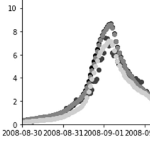 The Simulating WAves Nearshore (SWAN, Booij et al. 1999) model is used widely for predictions of waves in coastal regions. Like other spectral wave models, SWAN uses parameterizations to represent wave evolution due to sources (e.g. wind), sinks (e.g. whitecapping, bottom friction, depth-limited breaking), and resonance (e.g. quadruplet and triad wave-wave interactions). Each parameterization is based typically on observational data to represent the transfer of energy to, from, and between waves. It is necessary for each term to represent its physical process, but it is also necessary for the terms to be calibrated collectively to represent their combined effects on wave evolution. The calibrated wave predictions can then be coupled with models for circulation and coastal flooding, e.g. ADvanced CIRCulation (ADCIRC, Luettich et al. 1992).
The Simulating WAves Nearshore (SWAN, Booij et al. 1999) model is used widely for predictions of waves in coastal regions. Like other spectral wave models, SWAN uses parameterizations to represent wave evolution due to sources (e.g. wind), sinks (e.g. whitecapping, bottom friction, depth-limited breaking), and resonance (e.g. quadruplet and triad wave-wave interactions). Each parameterization is based typically on observational data to represent the transfer of energy to, from, and between waves. It is necessary for each term to represent its physical process, but it is also necessary for the terms to be calibrated collectively to represent their combined effects on wave evolution. The calibrated wave predictions can then be coupled with models for circulation and coastal flooding, e.g. ADvanced CIRCulation (ADCIRC, Luettich et al. 1992).
SWAN release version 41.20 included a new “package” of wave physics (referred to as ST6 physics). This package has new parameterizations of wind input, whitecapping, swell dissipation, wind speed scaling, and other processes (Rogers et al. 2012). The ST6 physics have been adopted by other wave models (e.g. NOAA’s WaveWatch III, Liu et al. 2019), and it may become the preferred physics package for SWAN. However, because the ST6 physics package has changes to so many parameterizations, it is necessary to quantify its effects on wave predictions. Recent studies (e.g. Aydogan and Ayat 2021) have demonstrated the benefits of using the ST6 physics in the standalone version of SWAN, but its effects have not been quantified for the coupled ADCIRC+SWAN (Dietrich et al. 2011a), which is used for real-time forecasts during impending storms. Do the ST6 physics improve the ADCIRC+SWAN wave predictions?


 Hurricane Katrina was historic in magnitude. From ref. 1: “The large size of Katrina throughout its history, combined with the extreme waves generated during its most intense phase, enabled this storm to produce the largest storm surges (reliable observations up to 28 ft) that have ever been observed within the Gulf of Mexico, as determined from analyses of historical records.” The analysis by Grinsted et al. of the effects of rising temperatures on the frequency of Atlantic hurricane surge invokes “events of Katrina magnitude” as a standard by which other events are judged. However, we believe the Katrina benchmark, as used, is seriously flawed, in large part because the tide gauge spatial resolution used was so coarse that none of the locations forming the index ever experienced a true surge event of Katrina magnitude. This casts doubt on the claim that Katrina-level surge events may occur many times per decade by the late 21st century.
Hurricane Katrina was historic in magnitude. From ref. 1: “The large size of Katrina throughout its history, combined with the extreme waves generated during its most intense phase, enabled this storm to produce the largest storm surges (reliable observations up to 28 ft) that have ever been observed within the Gulf of Mexico, as determined from analyses of historical records.” The analysis by Grinsted et al. of the effects of rising temperatures on the frequency of Atlantic hurricane surge invokes “events of Katrina magnitude” as a standard by which other events are judged. However, we believe the Katrina benchmark, as used, is seriously flawed, in large part because the tide gauge spatial resolution used was so coarse that none of the locations forming the index ever experienced a true surge event of Katrina magnitude. This casts doubt on the claim that Katrina-level surge events may occur many times per decade by the late 21st century.